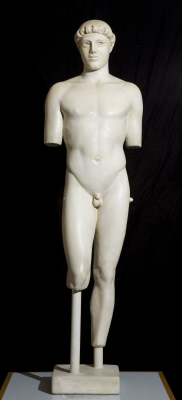
After an original statue by sculptor Kritios, ca 478 BCE
This plaster cast reproduces a marble statue, known as ‘The Kritios Boy’, excavated from the Athenian Acropolis in 1866. The original statue may have been a representation of the Greek hero Theseus or a dedication in honour of a young victor in an Athenian sports competition. The sculpture was one of the first known to depict the contrapposto pose, and it marks a breakthrough in realistic rendering of the human body.
Heroes had their own unique place in both the Greek and Roman religions. Not only did they have sanctuaries, shrines and altars like the gods, but also the tombs, bones and relics of ordinary mortals. Heroes were remembered, respected and invoked by the living at their tombs, since many thought that they could influence contemporary events. Over time, the number and variety of heroic cults increased to the extent that even outstanding athletes and those who were powerful in life were heroised once they died.
DETAILS
Plaster Cast Copy of The Kritios Boy. Ref JLMC CC15
Teece Museum of Classical Antiquities
UC Arts City Location
3 Hereford St, Christchurch
